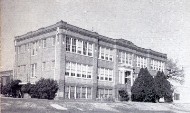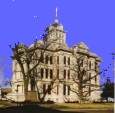Milam County Historical Commission
Milam County, Texas
All credit for these articles go to
Susie Sansom-Piper and
the Rockdale Reporter
Milam County, Texas
All credit for these articles go to
Susie Sansom-Piper and
the Rockdale Reporter






ON THE OTHER SIDE OF THE TRACKS, SERIES 7, PART 3
By SUSIE SANSOM-PIPER - Reporter contributor
Rockdale Reporter - 2014-02-20
Changes Begin in 40s, Early 50s
Part 3 in this seventh series dedicated to Black History Month.
By 1935, the 11th grade had been added to the curriculum at Aycock School, so students who had completed the 10th grade could receive their high school diploma at Aycock.
By the late ‘40s, little change had been made in public schools. On one occasion, when the distribution of textbooks were issued to the only two public schools, the textbooks were stacked in two columns, new and used. The new textbooks remained at the white school and the used were for the black school.
There was little change in living conditions until 1941. When war broke out in 1941, conditions became more visible. The Japanese had bombed Pearl Harbor, thus World War II was in full force.
Many of the young men in Rockdale were drafted into various branches of the armed services, and as they moved about in new surroundings, they noted that living conditions were different, and that improvements could be made.
Many of the citizens on the south side of the tracks were fortunate enough to get electricity and a water hydrant in the yard, but working conditions still involved dishwashing, maid service and cotton picking. Walking five and 10 miles to attend school, or other places, was the only way black people could get around.
If you rode the Continental Trailways bus to another town, you could not sit in the front, but were always asked to retreat to the back. As the views of returning servicemen changed the views of the world, Rockdale was also to be a part of these changes.
Rockdale became a focus point, when Marion T. Benson, a Rockdale native, who had been drafted in the navy, was on the ship Arizona when it was bombed at Pearl Harbor. He was a survivor.
This particular event served to be “a crack in the door” for civil rights, for separatism because of race, was soon obsolete in the armed services.
Eural N. Davis, a returning WWII Vet, also made history for his hometown in the forties, for he was a member of the famous Drake Relay Team, earning the title of “First black to travel with an integrated relay team.
The community faced new changes in the fifties, the establishment of Alcoa, the consolidation of rural schools with Aycock High School (Little Two, Liberty Hill, Tanglewood, Coxes Providence, Sharp, Tracy, Milano and in later years, Davilla).
Some families moved into the city, and some students were bused. The community kept the same dedicated and cooperative spirit, and through the entrepreneurship, personal contributions, a dedicated Parent-Teacher Association and Band Boosters’ Club, many needy school items, band uniforms, and general equipment was given to the school.
The 50s were productive years, for they produced champions in football, basketball, track, band, and academic competition. Segregation still existed, but unknown to many, there was comradeship between white and black basketball players and band members on both sides of the tracks.
Restrooms were still segregated. The back door dining was yet available, and the theaters still maintained their “chicken roost seats.”
Common civil rights just did not exist. But still, little or no major crimes crossed the area. This community just kept focusing on an attitude of “We can all get along.”
LATE 40S-EARLY 50S - These are a few of Aycock High graduates and their accomplishments from the late 40s-early 50s: *Ora Viola Scott—Teacher, first black in State Education Agency (1965).
Dr. Jew Don Boney—University president, Houston City council member.
Dr. James L. Johnson—Professor, Texas Southern University. Dr. Samuel Tucker—Professor, Grambling University. *Ruthie Mae Johnson, Flora Fair, Helen Crayton, Mildred Wilhite, Matthew Cook, Margaret Banks, Fannie Lovelady,* Margaret Sanders, Barbara Sansom,* Fred Wilhite, O. E. Wilhite, Jr. Annie B. Flemings, Emorial J. Matson, Uline Lovelady, Artis Ruth Lovelady, Daisy Alexander, *Johnnie Sanders, Bobbie Nell Richards — Professional teachers.
W. V. Moore – Mortician. Lillian Bacy, Annie Marie Denmon, Emma L. Banks, Allie M. Banks, Bertha Thompson, Eula A. Sansom - Registered Nurses.
Leo Scott — Pharmacist, minister, Abilene City Council. Bette L. (Smith) Williams - First black woman on Rockdale City Council.
Willie Ray Bacy — Radiologist. Lovie M. Molden—Travis County Corrections Office. Billy Gray—Business owner. D. Lee Alcorn—Cryptologist, radiologist, City Council of Grand Prairie.
Billy Ray Locklin, James Leroy Wright - Professional Athletes in football, basketball.
Bob Roberson - First black postal superintendent in Arizona. Dr. Glen Lovelady—Inventor, aerospace chemist.
Laurence Bacy — Minister, engineer.
*William Preston Moultrie - First Stanford University black track Coach, head of athletic department at Howard University. *Current Rockdale residents.
.
By SUSIE SANSOM-PIPER - Reporter contributor
Rockdale Reporter - 2014-02-20
Changes Begin in 40s, Early 50s
Part 3 in this seventh series dedicated to Black History Month.
By 1935, the 11th grade had been added to the curriculum at Aycock School, so students who had completed the 10th grade could receive their high school diploma at Aycock.
By the late ‘40s, little change had been made in public schools. On one occasion, when the distribution of textbooks were issued to the only two public schools, the textbooks were stacked in two columns, new and used. The new textbooks remained at the white school and the used were for the black school.
There was little change in living conditions until 1941. When war broke out in 1941, conditions became more visible. The Japanese had bombed Pearl Harbor, thus World War II was in full force.
Many of the young men in Rockdale were drafted into various branches of the armed services, and as they moved about in new surroundings, they noted that living conditions were different, and that improvements could be made.
Many of the citizens on the south side of the tracks were fortunate enough to get electricity and a water hydrant in the yard, but working conditions still involved dishwashing, maid service and cotton picking. Walking five and 10 miles to attend school, or other places, was the only way black people could get around.
If you rode the Continental Trailways bus to another town, you could not sit in the front, but were always asked to retreat to the back. As the views of returning servicemen changed the views of the world, Rockdale was also to be a part of these changes.
Rockdale became a focus point, when Marion T. Benson, a Rockdale native, who had been drafted in the navy, was on the ship Arizona when it was bombed at Pearl Harbor. He was a survivor.
This particular event served to be “a crack in the door” for civil rights, for separatism because of race, was soon obsolete in the armed services.
Eural N. Davis, a returning WWII Vet, also made history for his hometown in the forties, for he was a member of the famous Drake Relay Team, earning the title of “First black to travel with an integrated relay team.
The community faced new changes in the fifties, the establishment of Alcoa, the consolidation of rural schools with Aycock High School (Little Two, Liberty Hill, Tanglewood, Coxes Providence, Sharp, Tracy, Milano and in later years, Davilla).
Some families moved into the city, and some students were bused. The community kept the same dedicated and cooperative spirit, and through the entrepreneurship, personal contributions, a dedicated Parent-Teacher Association and Band Boosters’ Club, many needy school items, band uniforms, and general equipment was given to the school.
The 50s were productive years, for they produced champions in football, basketball, track, band, and academic competition. Segregation still existed, but unknown to many, there was comradeship between white and black basketball players and band members on both sides of the tracks.
Restrooms were still segregated. The back door dining was yet available, and the theaters still maintained their “chicken roost seats.”
Common civil rights just did not exist. But still, little or no major crimes crossed the area. This community just kept focusing on an attitude of “We can all get along.”
LATE 40S-EARLY 50S - These are a few of Aycock High graduates and their accomplishments from the late 40s-early 50s: *Ora Viola Scott—Teacher, first black in State Education Agency (1965).
Dr. Jew Don Boney—University president, Houston City council member.
Dr. James L. Johnson—Professor, Texas Southern University. Dr. Samuel Tucker—Professor, Grambling University. *Ruthie Mae Johnson, Flora Fair, Helen Crayton, Mildred Wilhite, Matthew Cook, Margaret Banks, Fannie Lovelady,* Margaret Sanders, Barbara Sansom,* Fred Wilhite, O. E. Wilhite, Jr. Annie B. Flemings, Emorial J. Matson, Uline Lovelady, Artis Ruth Lovelady, Daisy Alexander, *Johnnie Sanders, Bobbie Nell Richards — Professional teachers.
W. V. Moore – Mortician. Lillian Bacy, Annie Marie Denmon, Emma L. Banks, Allie M. Banks, Bertha Thompson, Eula A. Sansom - Registered Nurses.
Leo Scott — Pharmacist, minister, Abilene City Council. Bette L. (Smith) Williams - First black woman on Rockdale City Council.
Willie Ray Bacy — Radiologist. Lovie M. Molden—Travis County Corrections Office. Billy Gray—Business owner. D. Lee Alcorn—Cryptologist, radiologist, City Council of Grand Prairie.
Billy Ray Locklin, James Leroy Wright - Professional Athletes in football, basketball.
Bob Roberson - First black postal superintendent in Arizona. Dr. Glen Lovelady—Inventor, aerospace chemist.
Laurence Bacy — Minister, engineer.
*William Preston Moultrie - First Stanford University black track Coach, head of athletic department at Howard University. *Current Rockdale residents.
.
This is the 37th consecutive year for Susie Piper to write a Black History Month series for The Reporter, and the seventh year for ‘On the Other Side of the Tracks.’ Previously she authored ‘Ebony Etchings,’ sketches of local African-Americans, for 27 years and also wrote a series entitled ‘Just Folks’ and ‘Way Back When.’